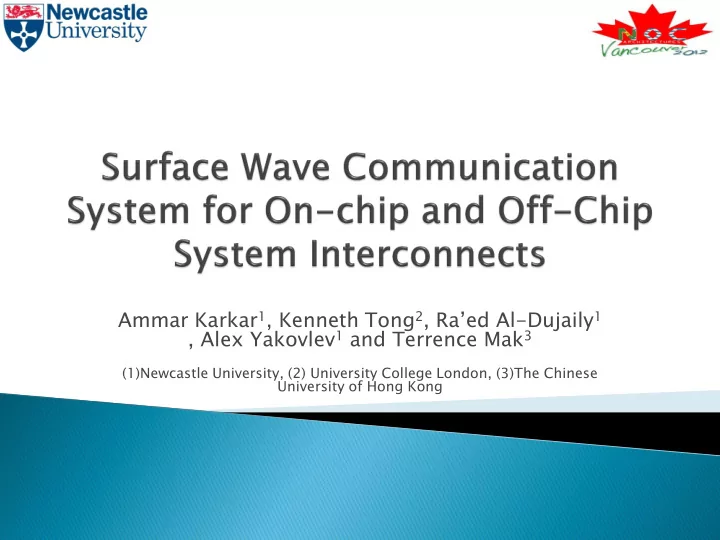

Ammar Karkar 1 , Kenneth Tong 2 , Ra’ed Al-Dujaily 1 , Alex Yakovlev 1 and Terrence Mak 3 (1)Newcastle University, (2) University College London, (3)The Chinese University of Hong Kong
Introduction Surface wave Hybrid architecture Analysis of link power dissipation Area estimation Preliminary results Conclusion 10/12/2012 2
Introduction Surface wave Hybrid architecture Analysis of link power dissipation Area estimation Preliminary results Conclusion 10/12/2012 3
Scalability is the issue: ◦ System-on-chip ◦ Network-on-chip ◦ Global communication ◦ Alternative communication fabric 10/12/2012 4
Introduction Surface wave Hybrid architecture Analysis of link power dissipation Area estimation Preliminary results Conclusion 10/12/2012 5
Why surface wave : ◦ Lower cost to implement: Does not require non-CMOS devices to be integrated (e.g. Optical Interconnect) less industrial challenges(e.g. 3D technology) ◦ Consume less power than wireless RF ◦ Provide one-to-many communication unlike(RF waveguide transmission lines) Surface wave Waveguide Wireless (less power) (less power) (one-to-many) (one-to-many ) 10/12/2012 6
Off-chip seems to be the better option for three reasons: ◦ lower implementation cost and mitigate area overhead ◦ used for both inter/intra-chip communication ◦ propagation speed, close to the speed of light (air as dielectric material) 10/12/2012 7
Introduction Surface wave Hybrid architecture Analysis of link power dissipation Area estimation Preliminary results Conclusion 10/12/2012 8
Shared media and limited number of frequency channels wire based local communication: ◦ scale well with technology ◦ cheapest implementation cost Hybrid multilayer Network: 10/12/2012 9
Introduction Surface wave Hybrid architecture Analysis of link power dissipation Area estimation Preliminary results Conclusion 10/12/2012 10
Proposed surface acts as wave guide of the propagated signal: ◦ 𝑊 + 𝑒 = 𝑊 + 0 𝑓 −𝛽𝑒 (1) ◦ 𝑇 21 = 𝐹 + 20 log 𝑓 −𝛽𝑒 (2) α ≈ 6.33 E ≈ -23.8 10/12/2012 11
Introduction Surface wave Hybrid architecture Analysis of link power dissipation Area estimation Preliminary results Conclusion 10/12/2012 12
Area overhead consideration for the proposed Interconnect fabric NoC component Baseline SWI Hybrid RF-I with Architecture Architecture transmission (proposed) line Router (mm 2 ) 1.08533 1.51237 1.51237 RF circuit (mm 2 ) - 0.408 0.463 Link (mm 2 ) - - 0.17152 active area overhead rate to 2.29% 2.3% baseline arch.(% of total die) 10/12/2012 13
Introduction Surface wave Hybrid architecture Analysis of link power dissipation Area estimation Preliminary results Conclusion 10/12/2012 14
6×4 Network average delay vs. PIR for 6×4 Network Throughput vs. PIR for Hybrid and Baseline Architecture Hybrid and Baseline Architecture 10/12/2012 15
Hybrid-Arch. PIR and throughput improvement over • Baseline Arch. At the edge of Network Saturation 50 45 40 35 (%) ent(% 30 vement Improvem 25 PIR 20 Throughput 15 10 5 0 Random Transpose Butterfly Shuffle Hotspot1 Hotspot2 Bitreversal Traffic ic 10/12/2012 16
Normalized Power consumption vs. Baseline architecture for Different NoC size, traffic 10/12/2012 17
Introduction Surface wave Hybrid architecture Analysis of link power dissipation Area estimation Preliminary results Conclusion 10/12/2012 18
Scalability issues in global communication Hybrid architecture (metal and SWI for local and global Communication, respectively) Significant potential of the proposed architecture to mitigate these issues with relatively small area penalty Future work includes developing an optimized topology on design time or on the fly, as well as, investigating 1-to-M/M-to-1 traffic pattern for this fabric. 10/12/2012 19
10/12/2012 20
Recommend
More recommend